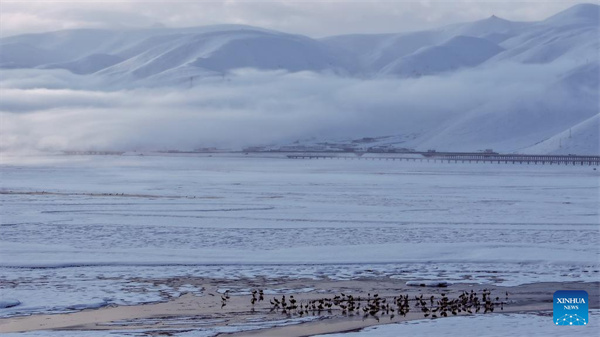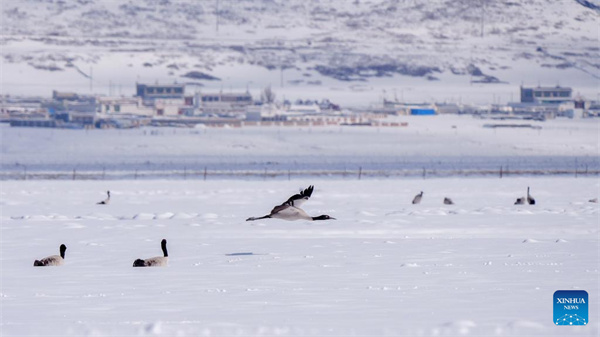Black-necked cranes spotted at wetland in China's Xizang
Updated: 2024-04-09 (Xinhua)  Print
Print 



A drone photo taken on April 7, 2024 shows the migrating black-necked cranes at the A Rag Wetland in Damxung county of Lhasa, Southwest China's Xizang autonomous region. The black-necked cranes, a species under first-class state protection in China, stop by and forage at the A Rag Wetland in Damxung county during their returning journey to the north every spring.
The wildlife conservators of the county are the busiest during this period. Nyima Dondrup, one of the local wildlife conservators, has been guarding the black-necked cranes at the wetland for 15 years.
"I find my efforts valuable when I watch the black-necked cranes flying," said Nyima Dondrup. [Xinhua/Dang Li]

Nyima Dondrup (R) and his colleague Tashi Dondrup patrol at the A Rag Wetland after snowfall in Damxung county of Lhasa, Southwest China's Xizang autonomous region, April 7, 2024. The black-necked cranes, a species under first-class state protection in China, stop by and forage at the A Rag Wetland in Damxung county during their returning journey to the north every spring.
The wildlife conservators of the county are the busiest during this period. Nyima Dondrup, one of the local wildlife conservators, has been guarding the black-necked cranes at the wetland for 15 years.
"I find my efforts valuable when I watch the black-necked cranes flying," said Nyima Dondrup. [Xinhua/Jiang Fan]

This photo taken on April 7, 2024 shows the migrating black-necked cranes at the A Rag Wetland in Damxung county of Lhasa, Southwest China's Xizang autonomous region. The black-necked cranes, a species under first-class state protection in China, stop by and forage at the A Rag Wetland in Damxung county during their returning journey to the north every spring.
The wildlife conservators of the county are the busiest during this period. Nyima Dondrup, one of the local wildlife conservators, has been guarding the black-necked cranes at the wetland for 15 years.
"I find my efforts valuable when I watch the black-necked cranes flying," said Nyima Dondrup. [Xinhua/Jiang Fan]

A drone photo taken on April 7, 2024 shows the migrating black-necked cranes at the A Rag Wetland in Damxung county of Lhasa, Southwest China's Xizang autonomous region. The black-necked cranes, a species under first-class state protection in China, stop by and forage at the A Rag Wetland in Damxung county during their returning journey to the north every spring.
The wildlife conservators of the county are the busiest during this period. Nyima Dondrup, one of the local wildlife conservators, has been guarding the black-necked cranes at the wetland for 15 years.
"I find my efforts valuable when I watch the black-necked cranes flying," said Nyima Dondrup. [Xinhua/Jiang Fan]

This photo taken on April 7, 2024 shows the migrating black-necked cranes at the A Rag Wetland in Damxung county of Lhasa, Southwest China's Xizang autonomous region. The black-necked cranes, a species under first-class state protection in China, stop by and forage at the A Rag Wetland in Damxung county during their returning journey to the north every spring.
The wildlife conservators of the county are the busiest during this period. Nyima Dondrup, one of the local wildlife conservators, has been guarding the black-necked cranes at the wetland for 15 years.
"I find my efforts valuable when I watch the black-necked cranes flying," said Nyima Dondrup. [Xinhua/Jiang Fan]

This photo taken on April 7, 2024 shows the migrating black-necked cranes at the A Rag Wetland in Damxung county of Lhasa, Southwest China's Xizang autonomous region. The black-necked cranes, a species under first-class state protection in China, stop by and forage at the A Rag Wetland in Damxung county during their returning journey to the north every spring.
The wildlife conservators of the county are the busiest during this period. Nyima Dondrup, one of the local wildlife conservators, has been guarding the black-necked cranes at the wetland for 15 years.
"I find my efforts valuable when I watch the black-necked cranes flying," said Nyima Dondrup. [Xinhua/Dang Li]

This photo taken on April 7, 2024 shows the migrating black-necked cranes at the A Rag Wetland in Damxung county of Lhasa, Southwest China's Xizang autonomous region. The black-necked cranes, a species under first-class state protection in China, stop by and forage at the A Rag Wetland in Damxung county during their returning journey to the north every spring.
The wildlife conservators of the county are the busiest during this period. Nyima Dondrup, one of the local wildlife conservators, has been guarding the black-necked cranes at the wetland for 15 years.
"I find my efforts valuable when I watch the black-necked cranes flying," said Nyima Dondrup. [Xinhua/Purbu Tsering]

This photo taken on April 7, 2024 shows the migrating black-necked cranes at the A Rag Wetland in Damxung county of Lhasa, Southwest China's Xizang autonomous region. The black-necked cranes, a species under first-class state protection in China, stop by and forage at the A Rag Wetland in Damxung county during their returning journey to the north every spring.
The wildlife conservators of the county are the busiest during this period. Nyima Dondrup, one of the local wildlife conservators, has been guarding the black-necked cranes at the wetland for 15 years.
"I find my efforts valuable when I watch the black-necked cranes flying," said Nyima Dondrup. [Xinhua/Purbu Tsering]

This photo taken on April 7, 2024 shows the migrating black-necked cranes at the A Rag Wetland in Damxung county of Lhasa, Southwest China's Xizang autonomous region. The black-necked cranes, a species under first-class state protection in China, stop by and forage at the A Rag Wetland in Damxung county during their returning journey to the north every spring.
The wildlife conservators of the county are the busiest during this period. Nyima Dondrup, one of the local wildlife conservators, has been guarding the black-necked cranes at the wetland for 15 years.
"I find my efforts valuable when I watch the black-necked cranes flying," said Nyima Dondrup. [Xinhua/Jiang Fan]

This photo taken on April 7, 2024 shows the migrating black-necked cranes at the A Rag Wetland in Damxung county of Lhasa, Southwest China's Xizang autonomous region. The black-necked cranes, a species under first-class state protection in China, stop by and forage at the A Rag Wetland in Damxung county during their returning journey to the north every spring.
The wildlife conservators of the county are the busiest during this period. Nyima Dondrup, one of the local wildlife conservators, has been guarding the black-necked cranes at the wetland for 15 years.
"I find my efforts valuable when I watch the black-necked cranes flying," said Nyima Dondrup. [Xinhua/Jiang Fan]

An aerial drone photo taken on April 7, 2024 shows the migrating black-necked cranes at the A Rag Wetland in Damxung county of Lhasa, Southwest China's Xizang autonomous region. The black-necked cranes, a species under first-class state protection in China, stop by and forage at the A Rag Wetland in Damxung county during their returning journey to the north every spring.
The wildlife conservators of the county are the busiest during this period. Nyima Dondrup, one of the local wildlife conservators, has been guarding the black-necked cranes at the wetland for 15 years.
"I find my efforts valuable when I watch the black-necked cranes flying," said Nyima Dondrup. [Xinhua/Jiang Fan]

Nyima Dondrup (L) and his colleague Tashi Dondrup observe the migrating black-necked cranes at the A Rag Wetland after snowfall in Damxung county of Lhasa, Southwest China's Xizang autonomous region, April 7, 2024. The black-necked cranes, a species under first-class state protection in China, stop by and forage at the A Rag Wetland in Damxung county during their returning journey to the north every spring.
The wildlife conservators of the county are the busiest during this period. Nyima Dondrup, one of the local wildlife conservators, has been guarding the black-necked cranes at the wetland for 15 years.
"I find my efforts valuable when I watch the black-necked cranes flying," said Nyima Dondrup. [Xinhua/Jiang Fan]








